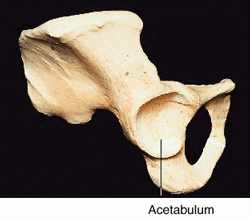-ectomy, -ectome, -ectomize
(Greek: a suffix; cut, excise, surgical removal of)
As opposed to an abdominal hysterectomy, a vaginal hysterectomy refers to the removal of the uterus through a surgical incision within the vagina. With a vaginal hysterectomy, the scar from the procedure is not outwardly visible.

The acromion is the lateral extension of the spine of the scapula, projecting over the shoulder joint and forming the highest point of the shoulder. It is also called the "acromial process" and "acromion scapulae".
The part that secretes growth hormone, fibroblast growth hormone, corticotropin, β-endorphin, thyrotropin, follicle-stimulating hormone, luteinizing hormone, and prolactin; these are released by hypophysiotropic hormones, releasing hormones secreted by the hypothalamus, and they regulate the functioning of the thyroid gland, gonads, adrenal cortex, and other endocrine organs.
As a consequence, the hypothalamo-pituitary unit is of vital importance to the growth, maturation, and reproduction of the individual.
*Ablation is usually carried out surgically; for example, the surgical removal of the thyroid gland (a total thyroidectomy) is an ablation of the thyroid.
The word ablation comes from the Latin ablatum, "to carry away".
Adenoidectomy is frequently done in conjunction with surgical removal of tonsils (tonsillectomy).
While the patient is under general anesthesia, the ear-nose-throat (ENT) surgeon inserts a small instrument into the mouth to prop it open.
The adenoid tissue can be removed with an instrument; such as, a curette or a microdebrider. Some surgeons may opt to cauterize the adenoids instead of removing the tissue. Bleeding is controlled with packing and cauterization.
The patient will remain in the recovery room after surgery until he is awake and able to breathe easily, cough, and swallow. Most patients are allowed to go home several hours later.
2. In gynecology, excision of the fallopian tube and ovary if unilateral and excision of both tubes and ovaries (adnexa uteri) if bilateral.
This plural Latin word is used in medicine in reference to appendages; for example, in gynecology the adnexa are the appendages of the uterus, namely the ovaries, Fallopian tubes (ducts or canals which conduct the ova from the ovaries to the uterus), and ligaments that hold the uterus in place.
Related cutting-word units: cast-; castrat-; -cise, -cide; mutil-; put-; sec-, seg-; temno-; -tomy; trunc-.
-Ectomy Word-Sources of Definitions

